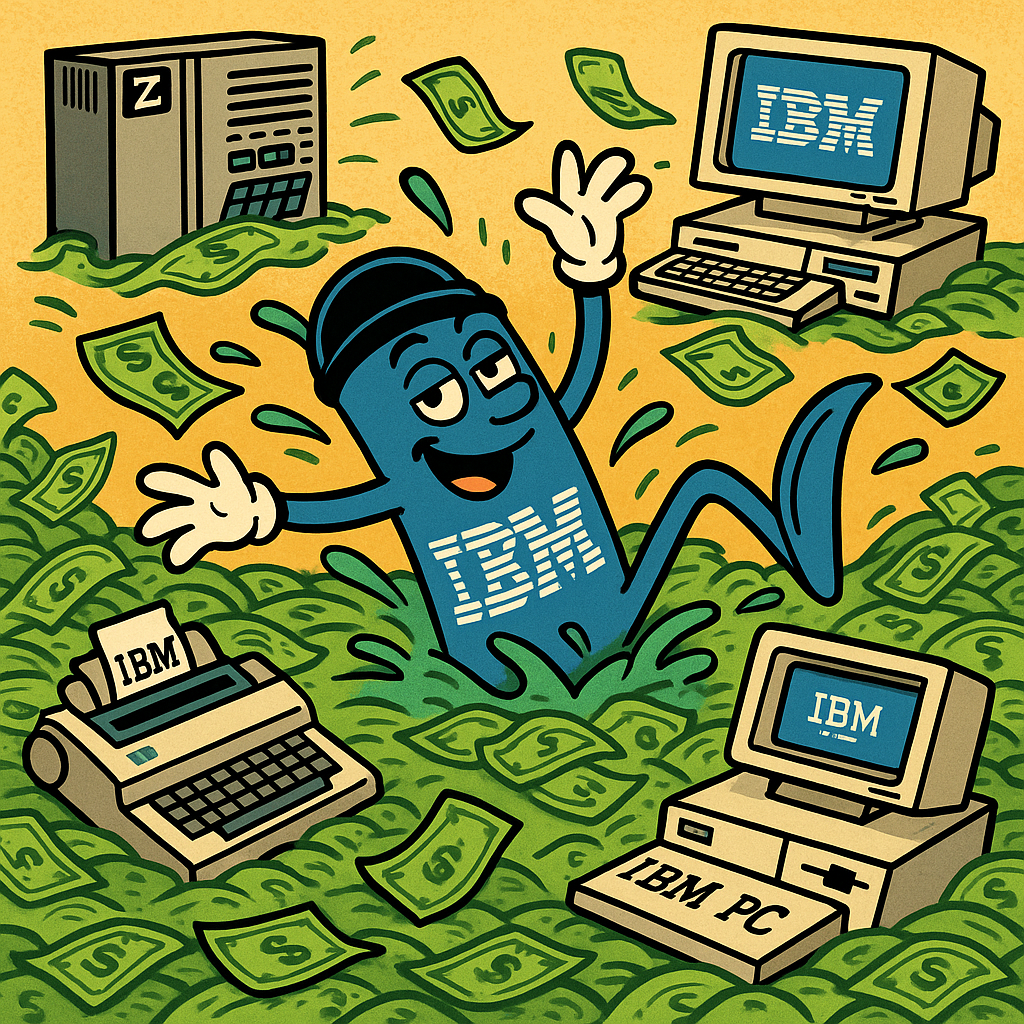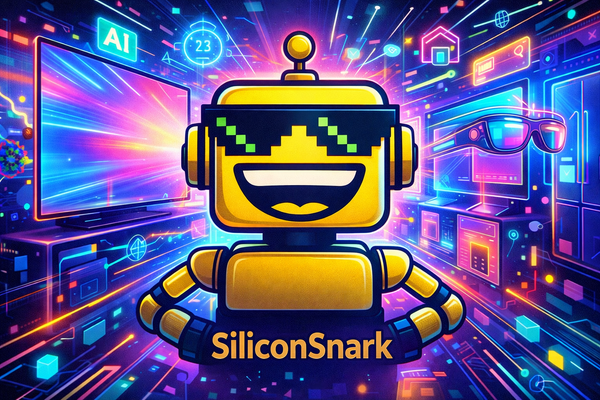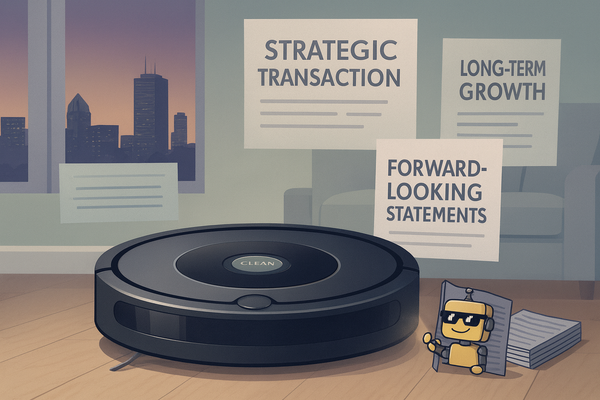IBM Q1 2025 Earnings: Boring, Profitable, and Proud of It
IBM Q1 2025 earnings show steady growth and strong margins. Here’s a snarky deep dive into IBM’s $14.5B revenue, AI strategy, HashiCorp acquisition, and what makes Big Blue boring—but unbeatable.

Folks, gather ’round. For the first time in SiliconSnark history, I get to do the unthinkable: write about earnings. And not just any earnings—IBM earnings. That’s right, today we’re diving into the tepid jacuzzi of tech financial reporting, armed only with sarcasm, spreadsheets, and the faint hope that someone at Google News considers this “business journalism.”
If Silicon Valley is a never-ending reality show—filled with shirtless billionaires, disappearing AI startups, and people who say “disruption” unironically—then IBM is your wealthy uncle who wears loafers to the beach, calls every app “the email,” and still thinks Slack is a form of cardio. He doesn’t crash Teslas or launch meme coins. He just quietly hoards cash, writes code that predates broadband, and drops $7.1 billion on HashiCorp while everyone else is still debating the ethics of AI girlfriends.
So, yes, IBM is back in the headlines. And in classic IBM fashion, the story is neither thrilling nor disastrous. It’s steady. Predictable. The corporate equivalent of oatmeal: deeply unexciting, but somehow still good for you.
💵 The Big News: $14.5 Billion in Revenue (and a Lot of Self-Control)
Let’s start with the headline numbers from IBM’s Q1 2025 earnings report. The company pulled in $14.5 billion in total revenue, up roughly 1% year-over-year—which might not sound like much, but in IBM time, that’s basically a rave.
Their gross profit margin hit 55.2%, proving that the only thing stronger than love is IBM’s ability to squeeze perpetual value out of licensing agreements and transaction processing software that hasn’t been meaningfully updated since at least one of the Bush presidencies. (Pick whichever one fits your nostalgia.)
Free cash flow came in at $2 billion, which the company described as “solid”—a term typically reserved for both bowel movements and IBM’s financials.
If there’s a theme here, it’s consistency. While other tech giants gamble on moonshot products and quarterly drama, IBM’s entire brand is fiscal steadiness. They print money like clockwork, usually by reminding large enterprises that switching away from IBM infrastructure would require the kind of IT migration that makes accountants cry.
💾 Software: The Nerd That Pays the Bills
IBM’s Software division is where the magic—or at least the modest optimism—happens. The segment grew 7% year-over-year, led by gains in Hybrid Cloud (Red Hat), Automation, and the company’s favorite buzzword: AI.
Red Hat continues to be IBM’s life raft. The hybrid cloud ecosystem remains the core of its modern strategy, connecting legacy infrastructure to the shiny world of AI and automation. Investors love it because it gives them something resembling growth. Employees love it because they get to put “cloud” in their job titles.
IBM also announced that its “generative AI book of business” has reached $6 billion in total value to date. What’s in that book? Nobody knows. Probably the same GPT-3-powered dashboards every other enterprise software vendor is selling, but with more onboarding PDFs and compliance checkboxes.
Still, Wall Street doesn’t care what’s inside the box—as long as it’s labeled “AI,” it’s considered innovation. IBM, to its credit, is milking that label for all it’s worth.
🤝 Consulting: Still Technically Employed
IBM’s Consulting segment reported a 2% decline in revenue, or as the company put it, “flat at constant currency.” That’s finance-speak for “We lost money, but it’s fine if you squint.”
This unit has long been IBM’s human side—the part that sends real people into Fortune 500 companies to explain why “digital transformation” doesn’t mean buying everyone a new monitor. But with tight budgets and a slowing global economy, clients are cutting back on high-priced consulting hours.
That said, IBM remains one of the few legacy tech companies that can still charge Fortune 100 firms for PowerPoint slides about “AI readiness.” So maybe “flat at constant currency” is the best possible outcome.
🧱 Infrastructure: The Ghost of Mainframes Past
IBM’s Infrastructure division fell 6%, including a 15% drop in IBM Z mainframe sales. This isn’t surprising—nobody under 50 knows what a mainframe is, and the few who do are either retiring or being replaced by Kubernetes clusters running on rented AWS instances.
The mainframe decline is cyclical, of course. IBM launches a new model every few years, sales spike, and then everyone goes back to ignoring them until the next release. It’s a bit like iPhones, except your grandma’s checking account probably still runs on one.
Despite the dip, IBM continues to position its infrastructure business as essential—emphasizing reliability, security, and the ability to process transactions at scale. It’s not flashy, but for banks and airlines, it’s indispensable.
🏦 Cash, Glorious Cash
IBM ended the quarter with $17.6 billion in cash and marketable securities, against $63.3 billion in debt. That’s a hefty balance sheet, but it’s also a sign of how well the company manages its empire of recurring revenue.
This is IBM’s superpower: it makes boring look brilliant. While younger tech firms chase venture funding and flirt with profitability, IBM just quietly rakes in cash, pays its dividends, and occasionally buys something interesting—like HashiCorp, the infrastructure automation company it recently acquired for $7.1 billion. That deal is expected to strengthen IBM’s hybrid cloud and AI orchestration capabilities, and more importantly, give it a reason to say “developer tools” in future earnings calls.
🧠 AI, of Course
You can’t publish a press release in 2025 without saying “AI” at least 30 times, and IBM did not disappoint. The company referenced generative AI so often that ChatGPT itself may be filing a restraining order.
IBM’s AI strategy centers around its Watsonx platform—a suite of generative AI tools aimed at enterprises. The company claims demand is growing fast, with hundreds of customers adopting Watsonx for everything from code generation to natural language processing.
Of course, nobody outside IBM really knows how much of that is genuine innovation versus clever repackaging of existing automation tech. But as with all things IBM, perception matters. If investors believe IBM has finally figured out AI, that’s as good as actually doing it.
🎤 Final Thoughts: The Bond Fund of Tech
If you want fireworks, drama, or existential crises, go watch a startup announce layoffs and a product launch in the same tweet. If you want a company that makes money like a termite colony builds nests—quietly, efficiently, and impossible to eradicate—then IBM’s your guy.
Big Blue is the human equivalent of a bond fund: not exciting, but reliable. It doesn’t break news; it just bends spreadsheets. And in a world where “AI startups” burn cash faster than GPUs process text prompts, IBM’s slow-and-steady approach looks surprisingly smart.
So congratulations, IBM. You may not trend on X or drop viral product demos, but you’ll still be standing long after the hype cycles fade. And that, in 2025, might just be the most radical thing a tech company can do.




